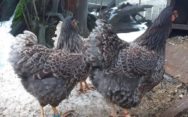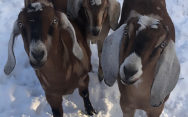Home -
Degenerative Encephalopathy Degenerative Encephalopathy

Dennis O’Brien DVM PhD, Chancellor’s Chair in Comparative Neurology
University of Missouri, College of Veterinary Medicine
Veterinary neurologists in Europe and America have recently recognized a new neurodegenerative disease in the Nova Scotia Duck Tolling Retriever (NSDTR). The disease is called Degenerative Encephalopathy with Sleep Disorders and Caudate Necrosis or simply Degenerative Encephalopathy (DE) for short. The term encephalopathy comes from the Greek words encephalo- (the brain) and –pathy (disease) and simply refers to a disorder of the brain. In this encephalopathy there is degeneration of a region the brain called the caudate nucleus. The caudate nucleus is a part of the brain that is important in controlling movement and some aspects of behavior. In DE, this portion of the brain undergoes necrosis or complete destruction of the area. One of the manifestations of caudate necrosis is a very unusual change where the dogs vigorously act out their dreams, and are difficult to awaken. Hence the name Degenerative Encephalopathy with Sleep Disorders and Caudate Necrosis.
Though this is a devastating disease, it does not appear to be common in the breed. Researchers at the University of Missouri have found a genetic mutation that is highly associated with DE. A DNA test for this mutation will permit the detection of dogs that have inherited two copies of the mutation and are at risk for developing the disease, and dogs that have inherited one copy of the mutation and have the potential of producing puppies that will develop the disease.
From the University of Missouri research team, THANK YOU to all the breeders, pet owners and veterinarians who contributed to this effort. We could not have done this work without your help!
What are the signs (symptoms) of the Degenerative Encephalopathy?
Dogs with DE show neurologic signs beginning at a young age. These signs become progressively worse with age and most affected dogs have been euthanized due to poor quality of life by 3-5 years of age. Some of the reported signs include:
- More anxious than normal after weaning but learn basic obedience
- Swimming in a more upright posture that does not improve with experience
- Increasing anxious behavior and difficulties learning with age
- Coordination loss: difficulty jumping, “choppy” gait, falls when making sharp turns
- Abnormal tail position
- Difficult to arouse from sleep and excessive running movements during dreams
- Hyper-vigilant behavior with obsessive barking at vehicles or other inanimate objects
- Excessive fixation on food
- Inappropriate aggression towards other dogs or people.
Many of the signs of DE, such as anxiousness, barking at cars, aggression toward other dogs, could be considered somewhat normal behaviors for a young dog still being trained. These behaviors in a dog with DE, however, take on a character where it is appears that the dog are losing control of their activities. The problems running, swimming or jumping that the dogs show also occur in other neurologic diseases that affect coordination. The sleep disorders that owners of the affected dogs describe are not commonly seen with other neurologic diseases. This is why they are highlighted in the name of the disease and warrant further discussion.
When a dog or a person sleeps, there are different phases to sleep. When we first fall asleep, our sleep is fairly light and we are easily awakened. With time, we go into a much deeper sleep that periodically gives way to dreams. The dreaming phase of sleep is called REM sleep. The REM stands for Rapid Eye Movements because if you watch the eyes of a person or dog during this phase, they are darting around beneath the eyelids as if they are watching the action of the dream. A dog cannot tell us what they experience, but everything about REM sleep in dogs suggests that they are also dreaming. During REM sleep, our brain is every bit as active as it is when we are awake. To prevent us from acting out our dreams, the brain blocks communication to the areas that control body movements. In people, the only part of the body that is not blocked is the eye, and hence the rapid eye movements. In dogs, this blockage is not as complete, and thus it is not unusual for dogs to have some small twitches of their paws or little yips as well as the eye movements during REM sleep. The caudate nucleus, that part of the brain that degenerates in DE, is a critical player in blocking the translation of our dreams into movement. Thus diseases that affect this area in people commonly have sleep disorders such as sleep walking or violent movements during sleep as a symptom. In dogs with DE, we see violent kicking and paddling movements during REM sleep.
Are there any risk factors (age, sex, genetic lines, etc.) for Degenerative Encephalopathy?
DE is an autosomal recessive hereditary disease. In a recessive disease, both parents of an affected pup can be normal. All animals have two copies of each gene, one that is inherited from the mother and one inherited from the father. A dog that has one normal gene and one bad (mutated) copy of a gene associated with a disease is a carrier of the trait. They show no symptoms because the one good gene is enough for their brain to function normally, but they will pass that bad gene on to about half of their offspring. If a carrier dog is bred to another carrier, then some of the pups (25% on average) may get a bad gene from each parent. Without one good gene to carry the day, the brain cannot function normally and the unlucky pup has the disease.
All the dogs with DE were born to normal parents and both sexes are equally affected. Several dogs have undergone extensive neurologic evaluations including MRI, spinal fluid analysis, tests for metabolic disease and post-mortem examination of the brain. No evidence of any other cause such as infection, trauma, brain tumors, toxicity or metabolic disease has been found in any of the dogs with DE.
How is Degenerative Encephalopathy diagnosed?
Many of the clinical signs of DE can be seen with other diseases of the nervous system such as liver shunts, back injuries or infections of the brain. The sleep disorder seen in DE, however, is not often seen with other diseases. Thus the combination of coordination loss, personality changes, and a sleep disorder would suggest a diagnosis of DE. A veterinary neurologist would be able to evaluate a dog showing such signs and ensure that some other condition was not the cause.
The degeneration of the caudate nucleus is the most specific finding that would confirm a diagnosis of DE. These changes can be readily seen on an MRI scan of the brain. Thus an MRI would be indicated in any NSDTR showing signs of DE. We know that these changes can be found in the dogs by 3 years of age, but we do not know what the earliest age that they can be detected is. This degeneration is also readily identified on a post-mortem examination of the brain.
The DNA test discussed below will identify dogs at risk for developing DE but appropriate clinical signs would need to be present for the veterinarian to confirm the diagnosis.
What are the treatment options for Degenerative Encephalopathy?
Until the underlying mechanism of the degeneration of the brain is better understood, only symptomatic therapy is available.
What is the prognosis of the Degenerative Encephalopathy?
Most of the affected dogs have been euthanized by 3-5 years of age due to poor quality of life and worries about aggression.
Is there a DNA test for Degenerative Encephalopathy?
Researchers at the University of Missouri have identified a mutation in a gene that is highly associated with degenerative encephalopathy with sleep disorder and caudate necrosis. The brain function that would be affected by this mutation is disrupted in similar neurodegenerative diseases in people. Dogs that have two copies of the mutation (homozygous) are at risk for developing DE. In some hereditary diseases, every dog that is at risk develops the disease. Other hereditary diseases show what is called variable penetrance. In diseases with variable penetrance, not every dog that is homozygous for the mutation develops disease. Further research is needed to determine whether this occurs with DE, but thus far, all the dogs with 2 mutated copies of the gene have shown signs of DE.
The DNA test can also identify carriers of the mutation. Continuing to use carriers for breeding wisely will maintain genetic diversity in the breed and thereby preserve desirable traits in that line. To prevent producing an affected pup, a carrier of the mutation should always be bred to a dog that has tested clear of the mutation by the DNA test. Approximately 50% of the offspring of that breeding will be carriers, so the offspring should then be tested for the mutation. Whether the pups are also carriers should then be one consideration when deciding which dogs will be kept as future breeding stock.
What research is going on to help us better understand Degenerative Encephalopathy?
The DNA test will allow identification of dogs at risk for developing DE and carriers of the mutation, but the situation in this disease may be more complex. There are reports of dogs showing behavior changes and coordination problems, but not the sleep disorder and necrosis of the caudate nucleus that are the hallmarks of DE. These dogs do not have the mutation associated with DE. Also one of the dogs with DE who had a post-mortem performed had additional changes in the brain that were not seen in other dogs with DE. This raises the question of whether there may be more than one brain disease in the breed. The DNA test will identify dogs with signs related to the mutation that has been identified. Those with signs of neurologic disease that do not have the mutation can then be studied further to determine if there is a second neurologic disease. Please visit http://www.caninegeneticdiseases.net/Toller for addition information and contact the researchers at the University of Missouri if you think you may have a dog with DE. The researches will keep all information provided to them confidential.
How can I DNA test my dog for DE?
A DNA test is now available to identify the genetic status of a dog for this gene mutation. The test will determine if the dog has 2 normal copies of the gene (normal), one normal copy and one mutated copy (carrier), or has 2 mutated copies and is at risk to develop clinical signs of DE. This test is available to order via the OFA website with DNA collected using a cheek swab. To order, go to www.OFFA.org and click on ORDER DNA TESTS.






